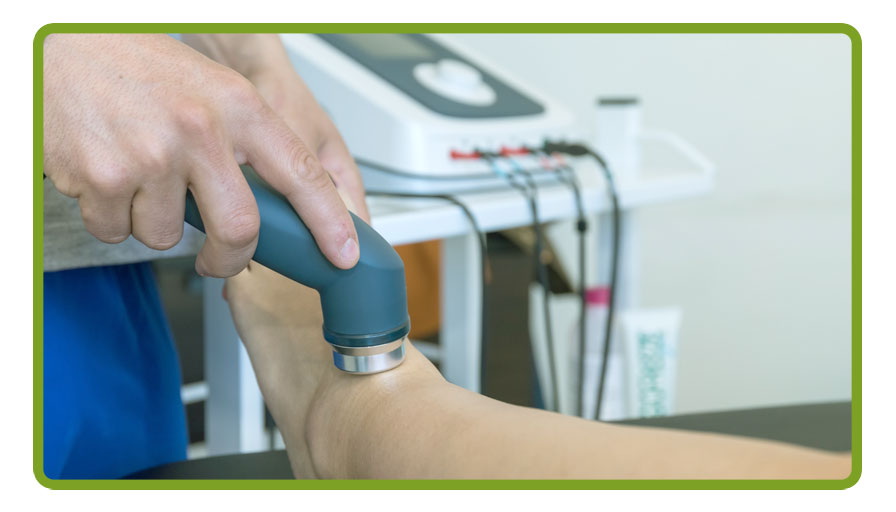Clinical Shockwave Therapy - Commonly Referred to as Radial Pressure Wave Therapy
Shockwave therapy is a medical procedure harnessing ultrasound technology to transmit high-energy acoustic waves into the targeted area. This process awakens the body's innate healing mechanisms, primarily by promoting the growth of fresh cells. These rejuvenated and robust cells take the place of older, debilitated, or impaired ones.
Shockwaves consist of concentrated ultrasonic energy, essentially high-frequency sound waves exceeding 20,000 Hz in vibration frequency. To put this into context, the typical human hearing range falls between 20 and 20,000 Hz.
Shockwave therapy is known by several names, such as:
- Radial pressure wave therapy (RPW), also known as radial shockwave therapy
- Extracorporeal shockwave therapy (ESWT)
- Focused shockwave therapy (FSW)
- Acoustic wave therapy
Several studies demonstrate that shockwave therapy, also called radial pressure wave therapy, is an effective non-surgical method for alleviating chronic pain.

In the 1990s, doctors initially employed shockwave therapy to address kidney stones. They noticed that this treatment appeared to expedite the healing process in both bones and soft tissues. This discovery prompted further research into various medical applications of RPW treatments.
The Advantages of Radial Shockwave Therapy
Clinical research spanning two decades highlights the effectiveness of RPW shockwave therapy in combating chronic pain and inflammation.
- Enhanced Blood Circulation:Shockwave therapy's acoustic waves induce micro-tears in tissues, prompting the body to generate new blood vessels. This heightened blood flow and oxygen supply to the treated area facilitate faster healing.
- Inflammation Reduction:Chronic inflammation often leads to discomfort and restricted mobility. Acoustice therapy waves stimulate mast cell activity, aiding in inflammation control.
- Boosted Collagen Production:Collagen plays a crucial role in maintaining the health of bones, joints, muscles, skin, and connective tissues. Shockwave therapy promotes collagen production, fortifying the support structure for new cells.
- Calcification Reduction:Damaged tendons tend to accumulate calcium deposits. Acoustic waves break down these deposits, enabling the body to naturally eliminate them.
- Pain Signal Interruption:The body communicates pain through Substance P, a neurotransmitter. Shockwave therapy reduces Substance P levels, disrupting pain signals and diminishing the inflammatory response, providing additional pain relief.
- Relief from Trigger Points:Intense muscle tension in areas like the back, neck, shoulders, and limbs, known as pain trigger points, hinders blood flow, leading to oxygen deprivation and waste buildup. This cycle, termed metabolic crisis, intensifies pain. Acoustic wave therapy releases tension in these trigger points, alleviating pain and breaking the cycle."
What sets apart Shockwave Therapy, Radial Pressure Wave Therapy, Acoustic Wave Therapy, Focused Shockwave Therapy, and Extracorporeal Shockwave Therapy?
While they all harness the fundamental power of sound waves to trigger changes within the body, the key distinction among them lies in the frequency of these sound waves, their speed, and how deeply and widely they reach within the body.

Here's the breakdown: Radial pressure wave therapy is best suited for areas closer to the skin, as it loses energy during its journey. On the other hand, Focused Shockwaves can delve much deeper, up to 12cm, while causing less impact on the surrounding tissues. Despite these differences, it's important to note that all of these therapies fall under the broader category of shockwave therapy. For an in-depth exploration of the principles behind shockwave therapy, including the generation and transmission of acoustic energy to the treatment site, you can refer to the detailed information provided by the International Society for Medical Shockwave Treatment on this page.
Shockwave Therapy is not limited to addressing only spinal discomfort through manipulation; its scope extends to the root causes of pain throughout the body.
Beyond its effectiveness in alleviating shoulder, back, and hip pain, this therapy proves valuable in the management of various other conditions. Among these are common foot ailments responsible for heel pain, including conditions like plantar fasciitis and the presence of bone spurs.
- Shoulder pain:Shoulder pain and restricted mobility can stem from calcification, chronic inflammation, or sudden injury. Most patients observe a significant reduction in symptoms after undergoing just four treatments.
- Hip Pain:As you age, your hip muscles and tendons often face strain from overuse. Radial Pressure Wave (RPW) therapy effectively reduces inflammation, expedites the healing process, and eliminates pain in this area.
- Jumper’s knee:Individuals grappling with challenging-to-treat conditions often experience immediate pain relief following their initial treatment.
- Tennis Elbow:Conventional remedies for epicondylitis, commonly referred to as tennis elbow, encompass steroid injections and pain-relieving medications. These methods offer no permanent solutions, and pain medications, in particular, carry a high risk of addiction. Shockwave therapy, on the other hand, provides lasting pain relief within just a few sessions.
- Plantar Fasciitis:Inflammation or injury to the plantar fascia, which connects the heel bone to the rest of the foot, results in heel pain. RPW therapy effectively relaxes the plantar fascia, fostering healing and alleviating heel discomfort.
- Bone spurs:Heel pain, often caused by calcium deposits on the heel bone leading to the formation of spurs, can be eased through acoustic waves that break down the calcification and relieve pain, restoring functionality.
- Chronic tendinopathy:Tendinopathy, a condition marked by chronic inflammation of the tendon, is commonly associated with the Achilles tendon but can occur elsewhere in the body. Patients usually find relief from their symptoms after three to five treatments.
- Medial tibial stress syndrome:Repetitive stress on the shins, typically due to activities like walking or running on hard or uneven surfaces, frequently triggers pain and inflammation. Shockwave therapy accelerates recovery, getting you back on your feet twice as fast as traditional RICE therapy (rest, ice, compression, elevation).
- Rotator cuff calcification:Conditions leading to pain and restricted range of motion can often result from inflammation and calcium deposits. Acoustic wave therapy effectively breaks down these deposits, providing prompt and enduring relief from symptoms.
- Insertional tendinitis:Achilles tendon inflammation, often attributed to calcification or the presence of a bone spur, benefits from RPW therapy by enhancing blood flow to the area, expediting healing, and reducing pain.


